Exploring the Impact of Electronic Commerce on Employment Rate: Panel Data Evidence from European Union Countries
Abstract
:1. Introduction
2. Literature Review and Hypotheses Development
2.1. The Impact of ICT on Employment Rate
2.2. The Influence of E-Commerce on Employment Rate
2.3. Economic Development—Research and Development—Employment Rate Nexus
3. Research Design
3.1. Database and Variables
3.2. Econometric Framework
4. Econometric Outcomes
4.1. Summary Statistics, Correlations, and Cluster Analysis
4.2. Panel Data Regression Model Results
5. Concluding Remarks and Policy Implications
Author Contributions
Funding
Institutional Review Board Statement
Informed Consent Statement
Data Availability Statement
Conflicts of Interest
Appendix A
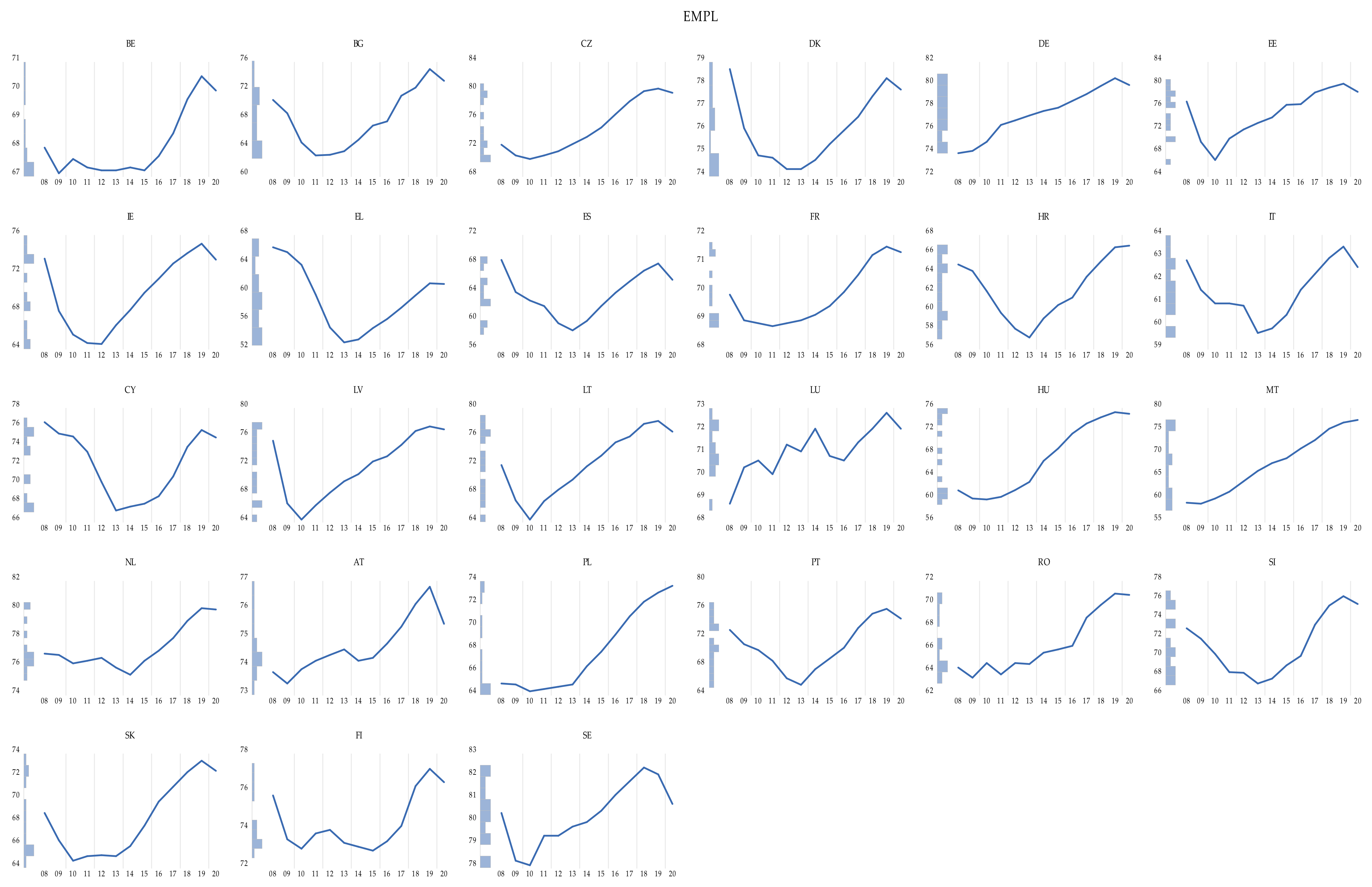
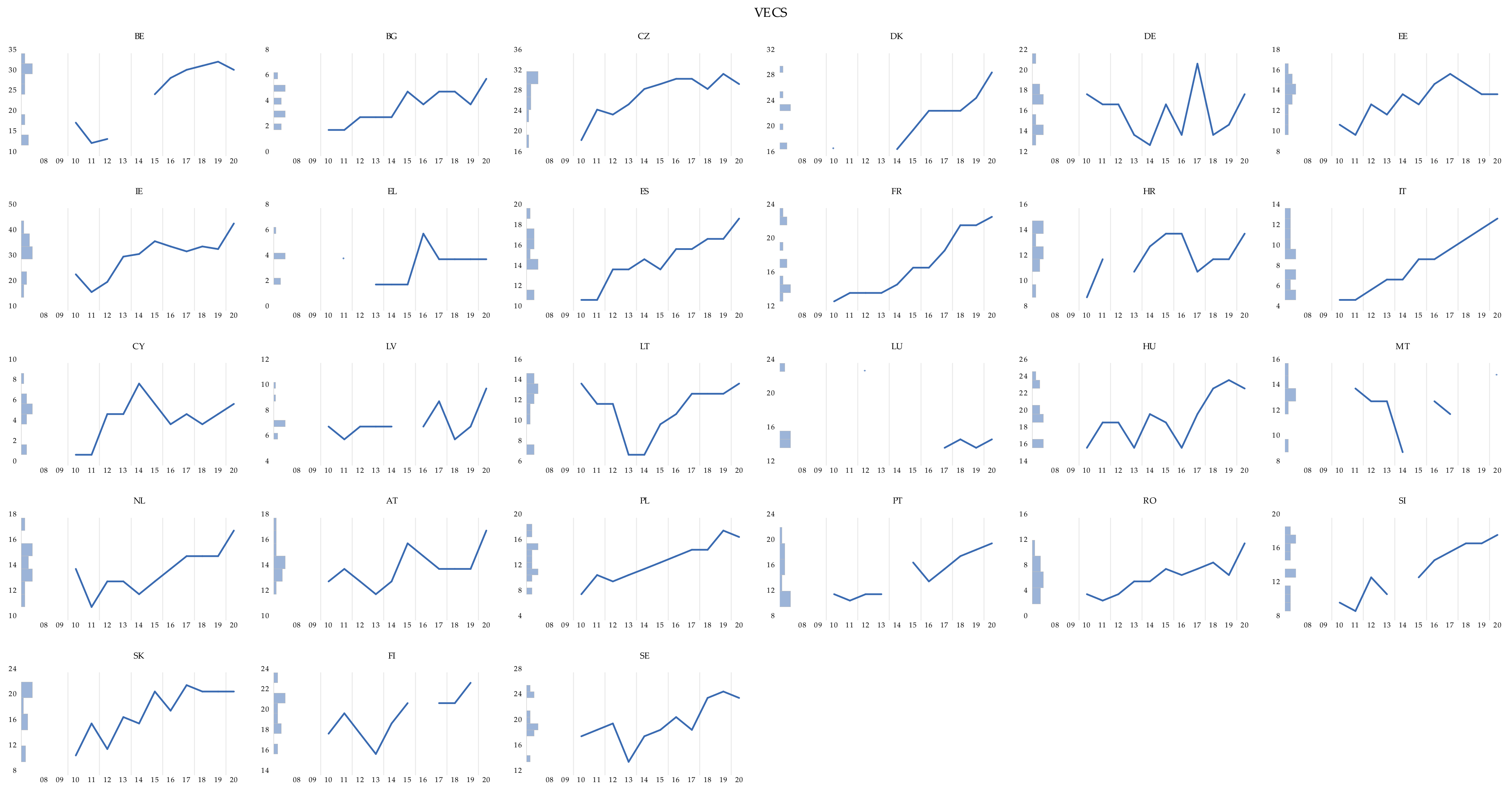
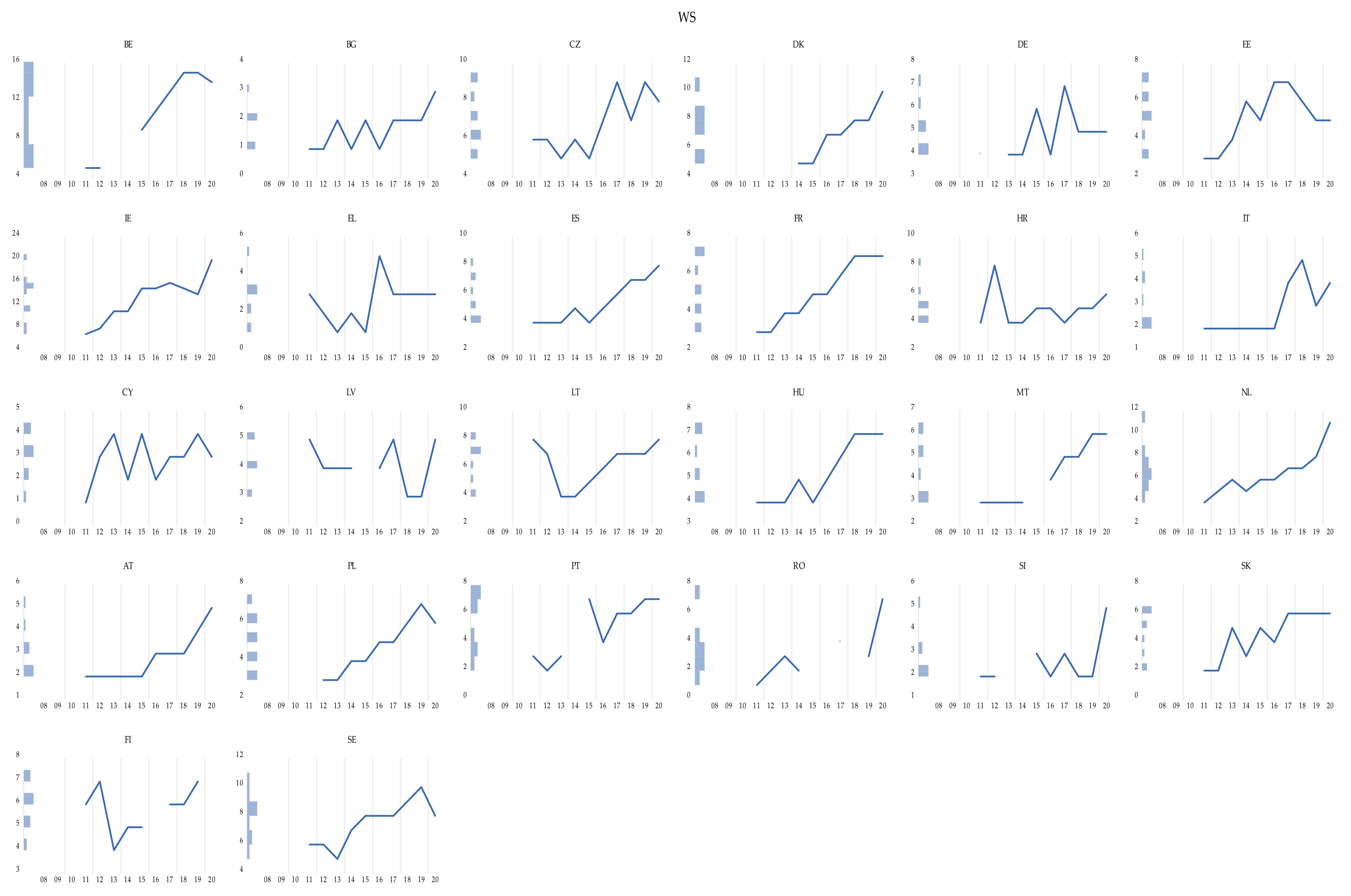
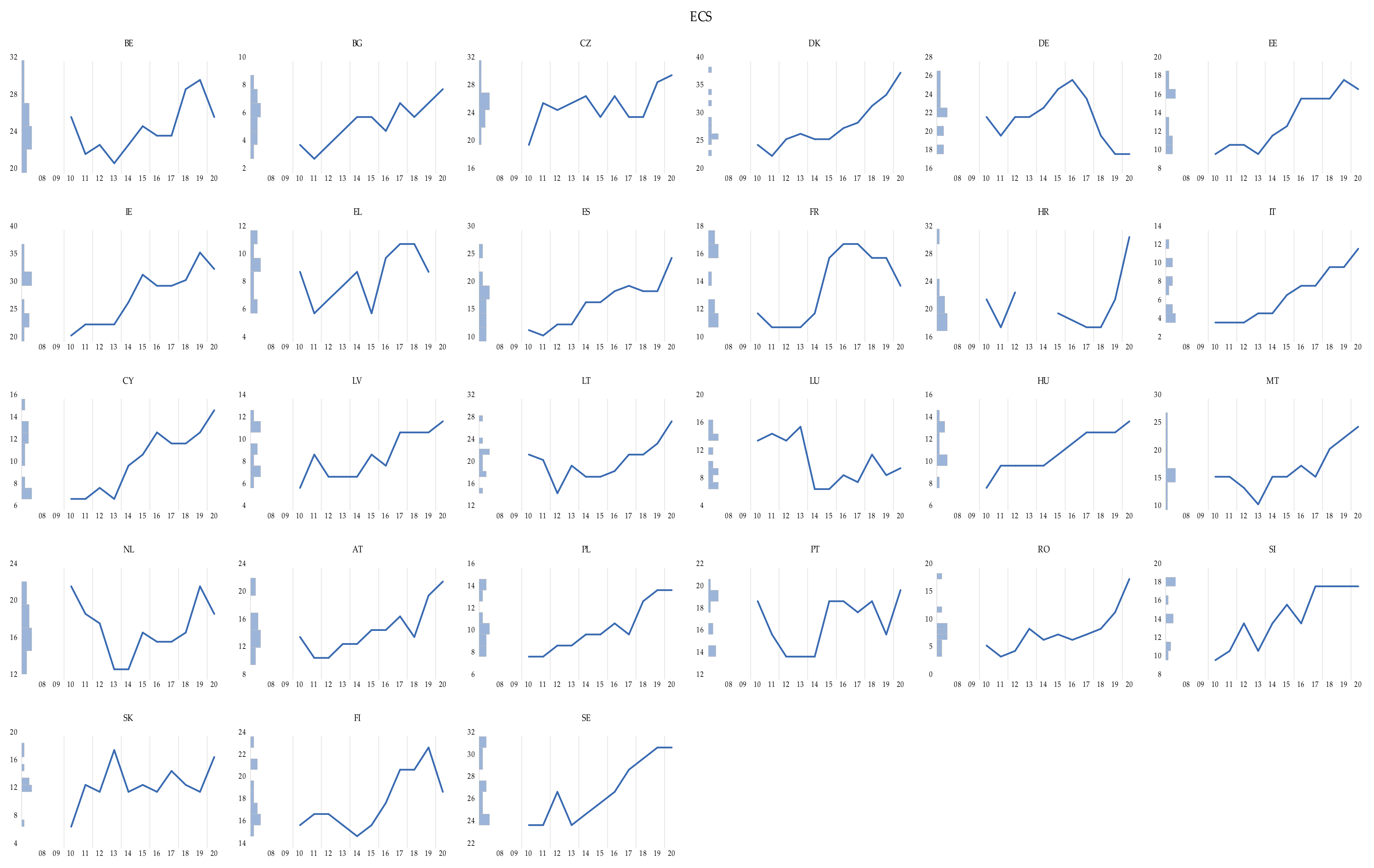
Appendix B
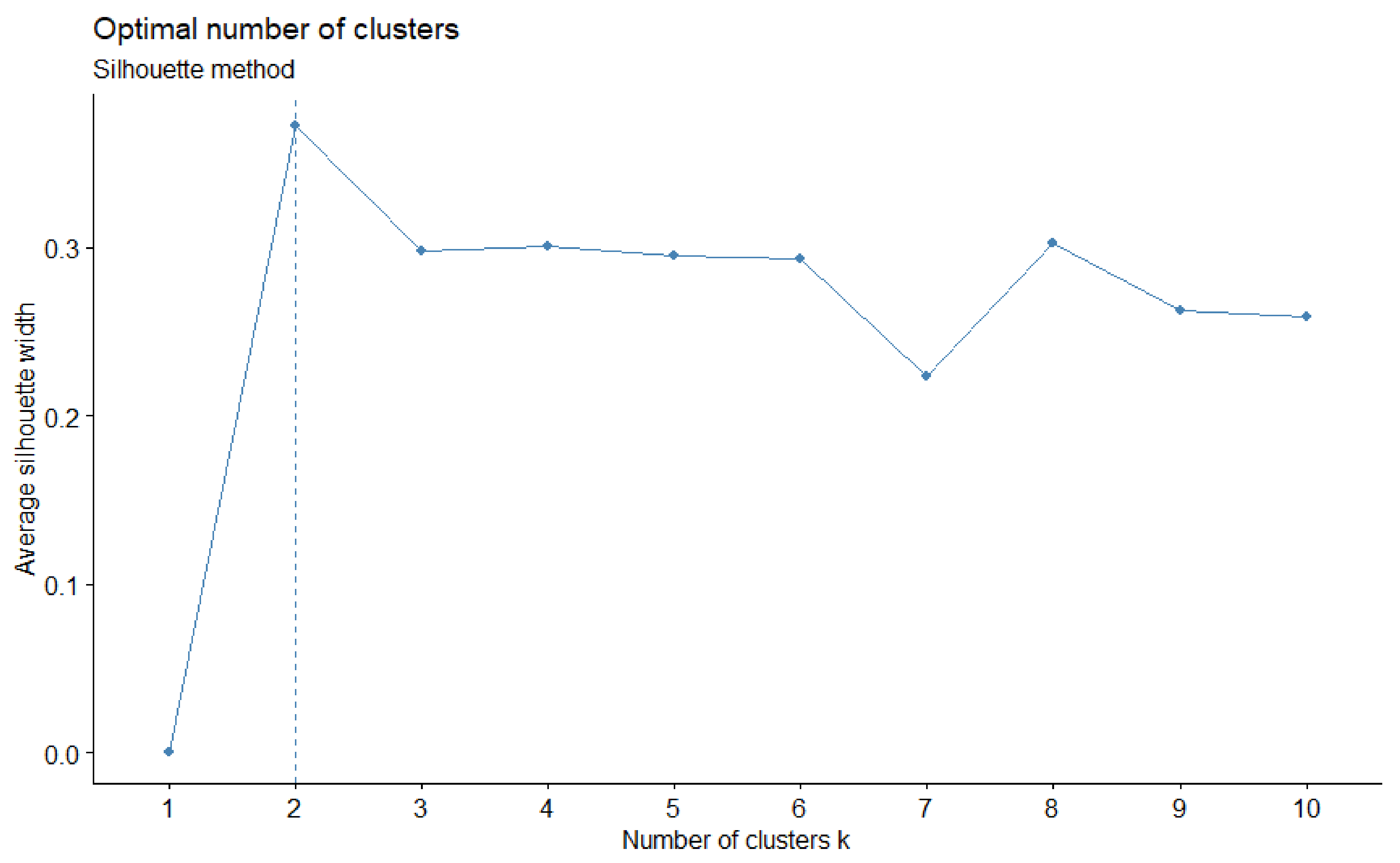


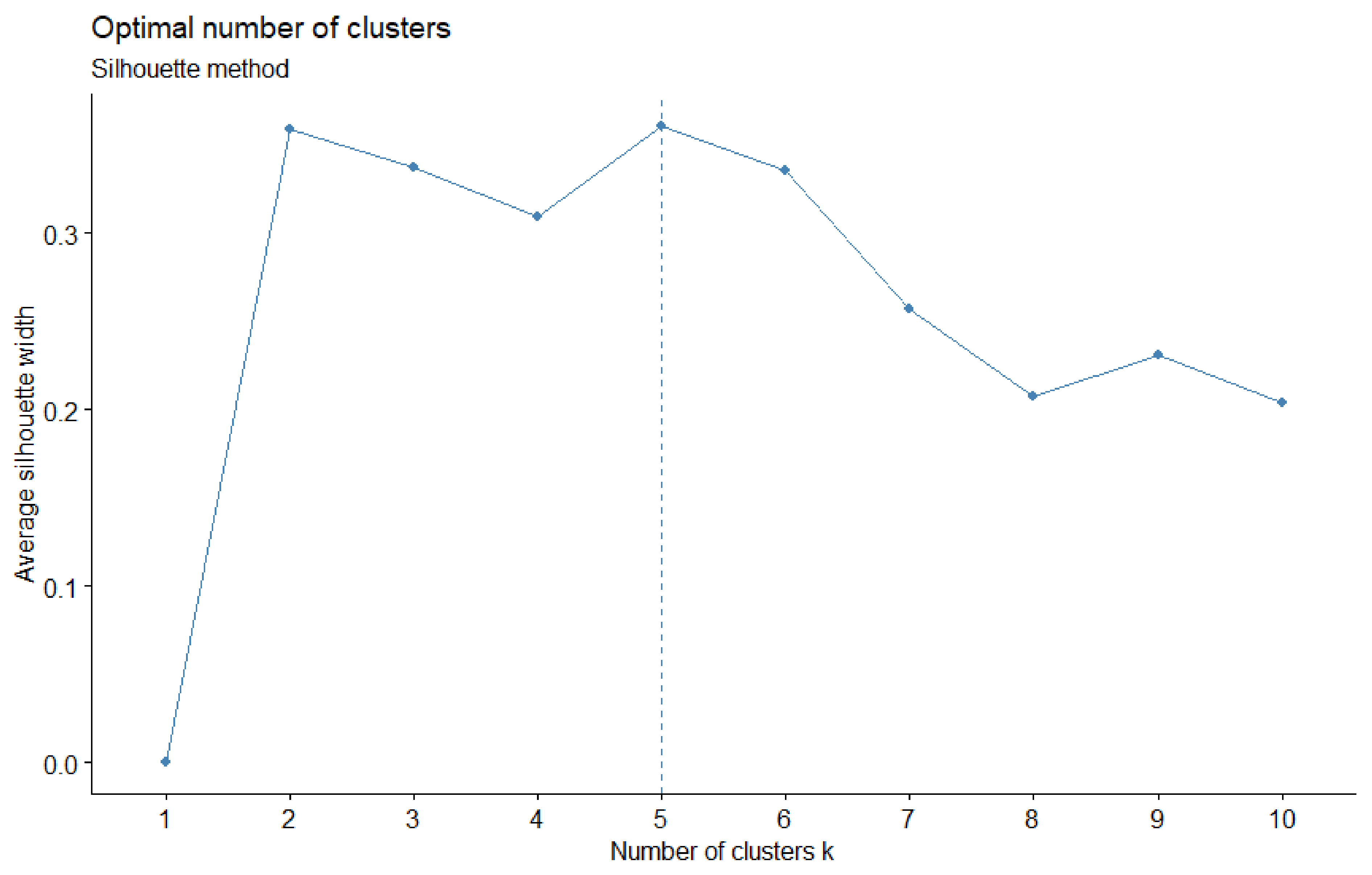
References
- Kapsos, S. The employment intensity of growth: Trends and macroeconomic determinants. Employ. Strategy Pap. 2005, 143–201. [Google Scholar]
- United Nations. Transforming our World: The 2030 Agenda for Sustainable Development; United Nations: New York, NY, USA, 2015. [Google Scholar]
- European Commission. EUROPE 2020 a Strategy for Smart, Sustainable and Inclusive Growth—COM(2010) 2020 Final; Publications Office of the European Union: Luxembourg, 2020. [Google Scholar]
- European Commission. A Digital Single Market Strategy for Europe—COM(2015) 192 Final; Publications Office of the European Union: Luxembourg, 2015. [Google Scholar]
- Biagi, F.; Falk, M. The impact of ICT and e-commerce on employment in Europe. J. Policy Model 2017, 39, 1–18. [Google Scholar] [CrossRef]
- Lone, S.; Harboul, N.; Weltevreden, J.W.J. 2021 European E-Commerce Report; Amsterdam University of Applied Sciences: Amsterdam, The Netherlands; Ecommerce Europe: Brussels, Belgium, 2021. [Google Scholar]
- World Economic Forum. The Future of Jobs Report 2020; World Economic Forum: Cologny, Switzerland, 2020. [Google Scholar]
- Zatonatska, T.; Fedirko, O. Modeling of the E-Commerce Impact on the Employment in EU. In Proceedings of the 2019 IEEE International Conference on Advanced Trends in Information Theory (ATIT), Kyiv, Ukraine, 18–20 December 2019. [Google Scholar]
- Zoroja, J.; Klopotan, I.; Ana-Marija, S. Quality of E-commerce practices in European enterprises: Cluster analysis approach. INDECS 2020, 18, 312–326. [Google Scholar] [CrossRef]
- Elhorst, J.P. The mystery of regional unemployment differentials: Theoretical and empirical explanations. J. Econ. Surv. 2003, 17, 709–748. [Google Scholar] [CrossRef]
- Pantea, S.; Sabadash, A.; Biagi, F. Are ICT displacing workers in the short run? Evidence from seven European countries. Inf. Econ. Policy 2017, 39, 36–44. [Google Scholar] [CrossRef]
- Falk, M.; Hagsten, E. E-commerce trends and impacts across Europe. Int. J. Prod. Econ. 2015, 170, 357–369. [Google Scholar] [CrossRef] [Green Version]
- Laitsou, E.; Kargas, A.; Varoutas, D. The impact of ICT on economic growth of Greece and EU-28 under economic crisis. In Proceedings of the 2017 Internet of Things Business Models, Users, and Networks, Aalborg University, Copenhagen, Denmark, 23–24 November 2017. [Google Scholar]
- Hanclova, J.; Doucek, P.; Fischer, J.; Vltavska, K. Does ICT capital affect economic growth in the EU-15 and EU-12 countries? J. Bus. Econ. Manag. 2016, 16, 387–406. [Google Scholar] [CrossRef] [Green Version]
- Antonopoulos, C.; Sakellaris, P. The contribution of information and communication technology investments to Greek economic growth: An analytical growth accounting framework. Inf. Econ. Policy 2009, 21, 171–191. [Google Scholar] [CrossRef]
- European Commission. The European Pillar of Social Rights Action Plan; Publications Office of the European Union: Luxembourg, 2021. [Google Scholar]
- Ward, M.R.; Zheng, S. Mobile telecommunications service and economic growth: Evidence from China. Telecommun. Policy 2016, 40, 89–101. [Google Scholar] [CrossRef]
- Shahiduzzaman, M.; Alam, K. Information technology and its changing roles to economic growth and productivity in Australia. Telecommun. Policy 2014, 38, 125–135. [Google Scholar] [CrossRef]
- Hodrab, R.; Maitah, M.; Smutka, L. The effect of information and communication technology on economic growth: Arab world case. Int. J. Trade Econ. Financ. Issue 2016, 6, 765–775. [Google Scholar]
- Nasab, E.H.; Aghaei, M. The effect of ICT on economic growth: Further evidence. Int. J. Bus. Adm. 2009, 5, 46–56. [Google Scholar]
- Purnama, Y.A.; Mitomo, H. The impact of ICT on regional economic growth: Empirical evidence from 34 provinces of Indonesia. In Proceedings of the 29th European Regional Conference of the International Telecommunications Society (ITS): “Towards a Digital Future: Turning Technology into Markets?”, Trento, Italy, 1–4 August 2018. [Google Scholar]
- Peng, G.; Wang, Y.; Han, G. Information technology and employment: The impact of job tasks and worker skills. Ind. Relat. J. 2018, 60, 201–223. [Google Scholar] [CrossRef]
- Sepehrdoust, H.; Khodaee, H. The impact of information and communication technology on employment of selected OIC countries. Afr. J. Bus. Manag. 2016, 7, 4149–4154. [Google Scholar] [CrossRef]
- Evangelista, R.; Guerrieri, P.; Meliciani, V. The economic impact of digital technologies in Europe. Econ. Innov. New Technol. 2014, 23, 802–824. [Google Scholar] [CrossRef]
- Bach, M.P. Exploring information and communications technology adoption in enterprises and its impact on innovation performance of European countries. Ekonomický časopis 2014, 62, 335–362. [Google Scholar]
- Abdollahpouri, M. ICT as a sustainable economic solution for emerging countries. WIT Trans. Ecol. Environ. 2016, 210, 337–344. [Google Scholar] [CrossRef] [Green Version]
- Kumar, V.; Arif, T.; Malik, M.B. Role of ICT in driving e-commerce business in developing countries. In Proceedings of the National Conference on Recent Innovations & Advancements in Information Technology, Department of Information Technology, BGSB University, Rajour, India, 26–27 November 2014. [Google Scholar]
- Jehangir, M.; Dominic, P.D.D.; Naseebullah, N.; Khan, A. Towards digital economy: The development of ICT and E-commerce in Malaysia. Mod. Appl. Sci. 2011, 5, 171–178. [Google Scholar] [CrossRef]
- Fang, C.; Yang, D.; Meiyan, W. Employment and Inequality Outcomes in China; Citeseer: Princeton, NJ, USA, 2009. [Google Scholar]
- Huang, W.-H.; Lin, Y.-J.; Lee, H.-F. Impact of population and workforce aging on economic growth: Case study of Taiwan. Sustainability 2019, 11, 6301. [Google Scholar] [CrossRef] [Green Version]
- Yakubu, M.M.; Akanegbu, B.N.; Jelilov, G. Labour Force participation and economic growth in Nigeria. Adv. Manag. Appl. Econ. 2020, 10, 1–14. [Google Scholar]
- Elkhalek, A.M.A.A. Economic development and participation of women in services sector: Empirical evidence from Egypt. Int. J. Financ. Econ. 2019, 11, 155–164. [Google Scholar] [CrossRef]
- Rama, M. Globalization and workers in developing countries. J. Stat. Soc. Inq. Soc. Irel. 2013. [Google Scholar] [CrossRef] [Green Version]
- Jenkins, R.O. Globalization, FDI and employment in Vietnam. Transnatl. Corp. 2006, 15, 115–142. [Google Scholar]
- Ioan, D. Employment—cause and effect of the economic growth. Procedia Econ. Financ. 2014, 8, 268–274. [Google Scholar] [CrossRef] [Green Version]
- Cyrek, M.; Fura, B. Employment for sustainable development: Sectoral efficiencies in EU countries. Soc. Indic. Res. 2019, 143, 277–318. [Google Scholar] [CrossRef] [Green Version]
- Flinn, C.J.; Heckman, J.J. Models for the Analysis of Labor Force Dynamics; Working Paper; National Bureau of Economic Research: Cambridge, MA, USA, 1982; pp. 1–94. [Google Scholar]
- Chen, W.; Niebel, T.; Saam, M. Are intangibles more productive in ICT-intensive industries? Evidence from EU countries. Telecommun. Policy 2016, 40, 471–484. [Google Scholar] [CrossRef] [Green Version]
- Erumban, A.A.; Das, D.K. Information and communication technology and economic growth in India. Telecommun. Policy 2016, 40, 412–431. [Google Scholar] [CrossRef]
- Botezatu, M.A. Organizational Sustainability, Modern Management and IT&C Impact on Local Development. In Proceedings of the International E-Conference “Enterprises in the Global Economy”, Timisoara, Romania, 14 October 2019. [Google Scholar]
- Atasoy, H.; Banker, R.D.; Pavlou, P.A. On the longitudinal effects of IT use on firm-level employment. Inf. Syst. Res. 2016, 27, 6–26. [Google Scholar] [CrossRef]
- Khan, A.G. Electronic commerce: A study on benefits and challenges in an emerging economy. GJMBR B Econ. Commer. 2016, 16, 255–259. [Google Scholar]
- Hecker, D.E. Employment impact of electronic business. Mon. Labor Rev. 2001, 124, 3–16. [Google Scholar]
- Terzi, N. The impact of e-commerce on international trade and employment. Procedia Soc. Behav. Sci. 2011, 24, 745–753. [Google Scholar] [CrossRef] [Green Version]
- Singh, S. Impact of internet and E-commerce on the labour market. Indian J. Ind. Relat. 2008, 43, 633–644. [Google Scholar]
- Jocevski, M.; Ghezzi, A.; Arvidsson, N. Exploring the growth challenge of mobile payment platforms: A business model perspective. Electron. Commer. Res. Appl. 2020, 40, 100908. [Google Scholar] [CrossRef]
- Ksenija, D.; Anita, P.; Irena, P. Internet banking usage in selected european countries: Multiple regression analysis approach. In Proceedings of the 12th International Symposium on Operational Research, Dolenjske Toplice, Slovenia, 25–27 September 2013; pp. 239–244. [Google Scholar]
- Domadenik, P.; Koman, M.; Redek, T. SHAPING the Future: Opportunities and Challenges of E-Commerce; Časnik Finance: Ljubljana, Slovenia, 2018. [Google Scholar]
- Bilerman, M.; Chua, J.; Guy, A.; McShane, K. Technology at Work v3.0: Automating E-Commerce from Click to Pick to Door; Citi GPS: Global Perspectives & Solutions, Oxford Martin School and Citi: Oxford, UK, 2017. [Google Scholar]
- Bram, J.; Gorton, N. How Is Online Shopping Affecting Retail Employment? Federal Reserve Bank: New York, NY, USA, 2017. [Google Scholar]
- Turban, E.; Outland, J.; King, D.; Lee, J.K.; Liang, T.-P.; Turban, D.C. Electronic Commerce 2018. A Managerial and Social Networks Perspective; Springer International Publishing: Cham, Switzerland, 2018. [Google Scholar]
- Meyersohn, N. Amazon Will Hire 125,000 Workers, Dangling $3000 Bonuses for Some Jobs. Available online: https://edition.cnn.com/2021/09/14/business/amazon-hiring-jobs/index.html (accessed on 25 September 2021).
- Zandi, M.; Koropeckyj, S.; Singh, V.; Matsiras, P. The Impact of Electronic Payments on Economic Growth; Moody’s Corporation: New York, NY, USA, 2016. [Google Scholar]
- Sedighi, A.; Sirang, B. The effect of E-commerce on SME performance. Int. J. Appl. Res. Manag. Econ. 2018, 1, 71–81. [Google Scholar]
- Jovanović, J.Š.; Vujadinović, R.; Mitreva, E.; Fragassa, C.; Vujović, A. The relationship between E-commerce and firm performance: The mediating role of internet sales channels. Sustainability 2020, 12, 6993. [Google Scholar] [CrossRef]
- Americo, A.; Veronico, A. The Effect of E-Commerce on Employment in Retail Sector; Mimeo: New York, NY, USA, 2018. [Google Scholar]
- Han, H.; Trimi, S. Social commerce design: A framework and application. J. Theor. Appl. Electron. Commer. Res. 2017, 12, 50–68. [Google Scholar] [CrossRef] [Green Version]
- Huang, Z.; Benyoucef, M. From e-commerce to social commerce: A close look at design features. Electron. Commer. Res. Appl. 2013, 12, 246–259. [Google Scholar] [CrossRef]
- Yun, Z.-S. Testing a Theoretical Model to Examine the Relationships Among E-Social Shopping Motivation, Perception, and Behavioral Intention; Michigan State University Retailing: East Lansing, MC, USA, 2011. [Google Scholar]
- Shafiee, M.M.; Bazargan, N.A. Behavioral customer loyalty in online shopping: The role of E-service quality and E-recovery. J. Theor. Appl. Electron. Commer. Res. 2018, 13, 26–38. [Google Scholar] [CrossRef] [Green Version]
- Fidan, H. Grey relational classification of consumers’ textual evaluations in E-commerce. J. Theor. Appl. Electron. Commer. Res. 2020, 15, 48–65. [Google Scholar] [CrossRef] [Green Version]
- Gyenge, B.; Máté, Z.; Vida, I.; Bilan, Y.; Vasa, L. A new strategic marketing management model for the specificities of E-commerce in the supply chain. J. Theor. Appl. Electron. Commer. Res. 2021, 16, 64. [Google Scholar] [CrossRef]
- Sumanjeet. Social implications of electronic commerce. J. Soc. Sci. 2009, 21, 91–97. [Google Scholar] [CrossRef]
- Chen, L. Retailers’ differentiation strategy and pricing in the rental market of digital content: A case of E-textbooks. J. Theor. Appl. Electron. Commer. Res. 2019, 14, 61–75. [Google Scholar] [CrossRef] [Green Version]
- Meghisan-Toma, G.-M.; Puiu, S.; Florea, N.M.; Meghisan, F.; Doran, D. Generation Z’ young adults and M-commerce use in Romania. J. Theor. Appl. Electron. Commer. Res. 2021, 16, 82. [Google Scholar] [CrossRef]
- Statista. Mobile Retail Commerce Sales as Percentage of Retail E-Commerce Sales Worldwide from 2016 to 2021. Available online: https://www.statista.com/statistics/806336/mobile-retail-commerce-share-worldwide/ (accessed on 26 March 2021).
- Savvy, M. Global Mobile eCommerce Statistics, Trends & Forecasts. Available online: https://www.merchantsavvy.co.uk/mobile-ecommerce-statistics/ (accessed on 26 March 2021).
- Lipsman, A. Global Ecommerce 2019. Available online: https://www.emarketer.com/content/global-ecommerce-2019 (accessed on 15 July 2021).
- Boateng, R.; Heeks, R.; Molla, A.; Hinson, R. E-commerce and socio-economic development: Conceptualizing the link. Internet Res. 2008, 18, 562–594. [Google Scholar] [CrossRef] [Green Version]
- Oliver Wyman. Is E-Commerce Good for Europe? Economic and Environmental Impact Study; Oliver Wyman: New York, NY, USA, 2021; pp. 1–119. [Google Scholar]
- Gala, P.; Camargo, J.; Freitas, E. Economic Commission for Latin America and the Caribbean (ECLAC). Electron. Commer. Int. Trade Employ. Rev. Issues 2002, 3, 633–651. [Google Scholar]
- Aydin, E.; Kavaklioglu, S. A study of superiority of e-trade compared to traditional methods of commerce in overcoming crises: Case study of kitapix.com. Procedia Soc. Behav. Sci. 2011, 24, 123–137. [Google Scholar] [CrossRef] [Green Version]
- ElFadily, S.; Kaddar, A. Modeling and mathematical analysis of labor force evolution. Model. Simul. Eng. 2019, 2019, 1–5. [Google Scholar] [CrossRef]
- Stanila, L.; Andreica, M.E.; Cristescu, A. Econometric analysis of the employment rate for the E.U. countries. Procedia Soc. Behav. Sci. 2019, 109, 178–182. [Google Scholar] [CrossRef] [Green Version]
- Elhorst, J.P.; Zeilstra, A.S. Labour force participation rates at the regional and national levels of the European Union: An integrated analysis. Pap. Reg. Sci. 2007, 86, 525–549. [Google Scholar] [CrossRef]
- Botha, I.; Botezatu, M.A.; Coanca, M. Innovative calculation model for evaluating regional sustainable development. Econ. Comput. Econ. Cybern. Stud. Res. 2020, 54, 5–24. [Google Scholar] [CrossRef]
- Vega, S.H.; Elhorst, J.P. Regional labour force participation across the European Union: A time–space recursive modelling approach with endogenous regressors. Spat. Econ. Anal. 2017, 12, 138–160. [Google Scholar] [CrossRef] [Green Version]
- Nekrep, A.; Strašek, S.; Boršič, D. Productivity and Economic Growth in the European Union: Impact of Investment in Research and Development. Naše Gospod. Our Econ. 2018, 64, 18–27. [Google Scholar] [CrossRef] [Green Version]
- Gocer, I.; Alatas, S.; Peker, O. Effects of R&D and innovation on income in EU countries: New generation panel cointegration and causality analysis. Theor. Appl. Econ. 2016, 23, 153–164. [Google Scholar]
- Ho, Y.P.; Wong, P.K.; Toh, M.H. The impact of R&D on the Singapore economy: An empirical evaluation. Singap. Econ. Rev. 2009, 54, 1–20. [Google Scholar] [CrossRef]
- Miroslava, V.; Borisb, M.; Olgac, I.; Mitjad, Č. R&D and economic growth in Slovenia: A dynamic general equilibrium approach with endogenous growth. Panoeconomicus 2011, 58, 67–89. [Google Scholar] [CrossRef]
- Ali-Yrkkö, J. Impact of Public R&D Financing on Employment; The Research Institute of the Finnish Economy (ETLA): Helsinki, Finland, 2005. [Google Scholar]
- Dortet-Bernadet, V.; Sicsic, M. The effect of R&D subsidies and tax incentives on employment: An evaluation for small firms in France. Econ. Stat. 2017, 493, 5–22. [Google Scholar] [CrossRef] [Green Version]
- Bong, K.H.; Park, S.; Park, J. What types of public R&D support increase employment performance? Evidence from Korean firm-level data. Appl. Econ. Lett. 2020, 27, 673–678. [Google Scholar] [CrossRef]
- Thomson, R.; Jensen, P. The effects of government subsidies on business R&D employment: Evidence from OECD countries. Natl. Tax. J. 2013, 66, 281–310. [Google Scholar] [CrossRef]
- Ciarli, T.; Marzucchi, A.; Salgado, E.; Savona, M. The Impact of R&D on Employment and Self-Employment Composition in Local Labour Markets; Working Paper; European Union: Brussels, Belgium, 2018; pp. 1–42. [Google Scholar]
- Hsiao, C. Panel data analysis—advantages and challenges. TEST 2007, 16, 1–22. [Google Scholar] [CrossRef] [Green Version]
- Blundell, R.; Mátyás, L. Panel data analysis: An introductory overview. Struct. Change Econ. D 1992, 3, 291–299. [Google Scholar] [CrossRef]
- Baltagi, B.H. Econometric Analysis of Panel Data, 6th ed.; Springer: Cham, Switzerland, 2021. [Google Scholar]
- Shaik, I.; Nittela, S.S.; Hiwarkar, T.; Nalla, S. K-means Clustering Algorithm Based on E-Commerce Big Data. IJITEE 2019, 8, 1910–1914. [Google Scholar] [CrossRef]
- Jain, A.K. Data clustering: 50 years beyond K-means. Pattern Recognit. Lett. 2010, 31, 651–666. [Google Scholar] [CrossRef]
- Blömer, J.; Lammersen, C.; Schmidt, M.; Sohler, C. Theoretical Analysis of the k-Means Algorithm—A Survey. In Algorithm Engineering: Selected Results and Surveys; Kliemann, L., Sanders, P., Eds.; Springer International Publishing: Cham, Switzerland, 2016. [Google Scholar]
- Hausman, J.A. Specification tests in econometrics. Econometrica 1978, 46, 1251–1271. [Google Scholar] [CrossRef] [Green Version]
- Machado, J.A.F.; Silva, J.M.C.S. Quantiles via moments. J. Econom. 2019, 213, 145–173. [Google Scholar] [CrossRef]
- Koenker, R. Quantile regression for longitudinal data. J. Multivar. Anal. 2004, 94, 74–89. [Google Scholar] [CrossRef] [Green Version]
- Canay, I.A. A simple approach to quantile regression for panel data. Econom. J. 2011, 14, 368–386. [Google Scholar] [CrossRef]
- Ecommerce Europe. Impact of the Coronavirus on E-Commerce; Survey Results Report, 21 January 2021; Ecommerce Europe: Brussels, Belgium, 2021; pp. 1–12. [Google Scholar]
- Ecommerce Europe. Impact of the Coronavirus on E-Commerce; Survey Results Report, 14 May 2020; Ecommerce Europe: Brussels, Belgium, 2020; pp. 1–45. [Google Scholar]
- Euromonitor. E-Commerce in Western Europe. 2020. Available online: https://www.euromonitor.com/e-commerce-in-western-europe/report (accessed on 28 September 2021).
- eMarketer. Western Europe to See $10.83 Billion More in Ecommerce Sales than Expected. Available online: https://www.emarketer.com/content/western-europe-see-10-83-billion-more-ecommerce-sales-than-expected (accessed on 28 September 2021).
- International Trade Administration. Ireland—Country Commercial Guide. Available online: https://www.trade.gov/knowledge-product/ireland-ecommerce (accessed on 28 September 2021).
- JP Morgan. E-Commerce Payments Trends: Ireland. Available online: https://www.jpmorgan.com/europe/merchant-services/insights/reports/ireland (accessed on 28 September 2021).
- JP Morgan. 2020 E-Commerce Payments Trends Report: Denmark. Available online: https://www.jpmorgan.com/merchant-services/insights/reports/denmark-2020 (accessed on 28 September 2021).
- Ecommercenews. Ecommerce in Denmark. Available online: https://ecommercenews.eu/ecommerce-in-europe/ecommerce-in-denmark/ (accessed on 28 September 2021).
- Nordea. E-Commerce in Sweden. Available online: https://www.nordeatrade.com/en/explore-new-market/sweden/e-commerce (accessed on 28 September 2021).
- PostNord. E-Commerce in Europe 2020; PostNord: Stockholm, Sweden, 2020. [Google Scholar]
- Mandel, M. How E-commerce is raising pay and creating jobs around the country. Forbes 2017, 11, 2019. Available online: https://www.forbes.com/sites/realspin/2017/04/03/how-e-commerce-is-raising-pay-and-creating-jobs-around-the-country/?sh=4f1db0c26dff (accessed on 28 September 2021).
- Rugaber, C.S. Why the explosive growth of e-commerce could mean more jobs. Denver Post, 29 October 2017; 1. [Google Scholar]
- Mandel, M. How Ecommerce Creates Jobs and Reduces Income Inequality; Progressive Policy Institute: Washington, DC, USA, 2007; Volume 3. [Google Scholar]
- Liao, D.; Valliant, R. Variance inflation factors in the analysis of complex survey data. Surv. Methodol. 2012, 38, 53–62. [Google Scholar]
- O’brien, R.M. A caution regarding rules of thumb for variance inflation factors. Qual. Quant. 2007, 41, 673–690. [Google Scholar] [CrossRef]
- Gujarati, D.N. Basic Econometrics, 4th ed.; Tata McGraw Hill: New York, NY, USA, 2004. [Google Scholar]
- Kleinbaum, D.G.; Kupper, L.L.; Nizam, A.; Rosenberg, E.S. Applied Regression Analysis and Other Multivariable Methods; Cengage Learning: Boston, MA, USA, 2014. [Google Scholar]
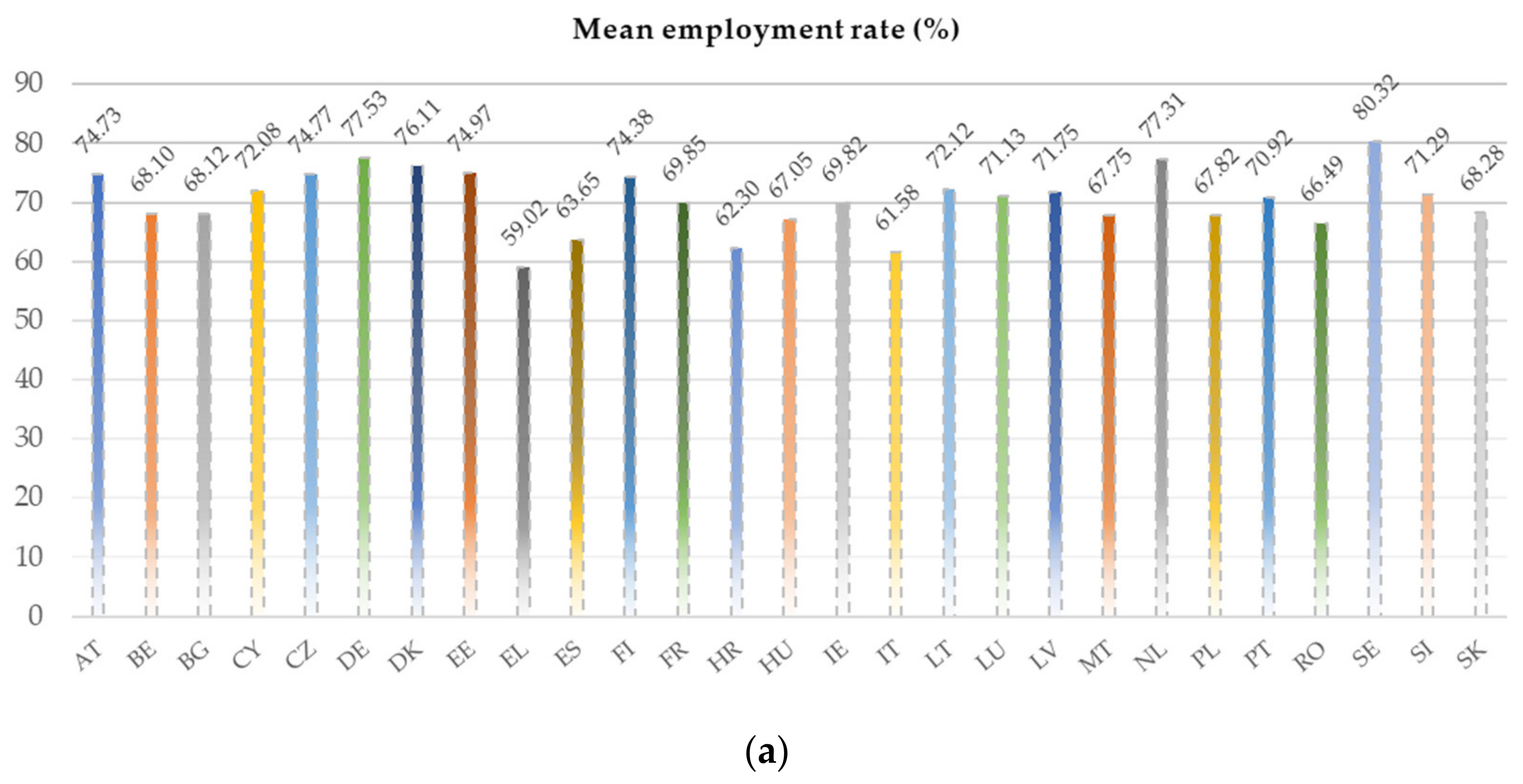


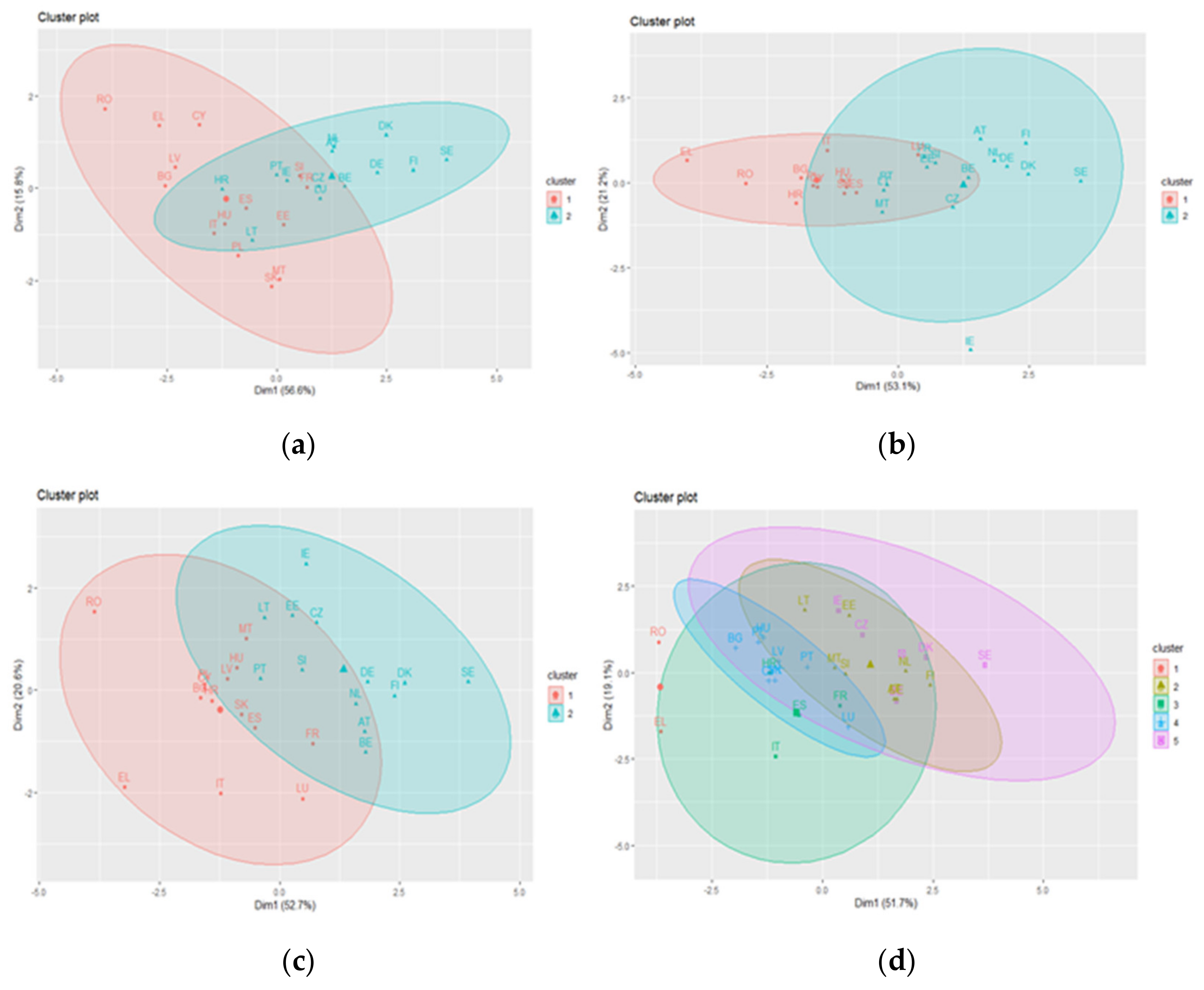
| Variables | Explanation | Meaning | Measurement | Data Source | Time Span |
|---|---|---|---|---|---|
| Dependent Variables Concerning Employment Rate | |||||
| EMPL | National employment rate by sex, age group 20–64—Total | The employment rate is calculated by dividing the number of persons aged 20–64 in employment by the total population of the same age group. The indicator is based on the EU Labour Force Survey | Percentage of total population | Eurostat [T2020_10] | 1993–2019 |
| Explanatory Variables Concerning E-Commerce | |||||
| VECS | Value of e-commerce sales | Enterprises’ total turnover from e-commerce sales—All enterprises, without financial sector (10 persons employed or more) | Percentage of turnover | Eurostat [ISOC_EC_EVALN2] | 2010–2020 |
| WS | Web sales | Enterprises’ turnover from web sales—All enterprises, without financial sector (10 persons employed or more) | Percentage of turnover | Eurostat [ISOC_EC_EVALN2] | 2009–2020 |
| ECS | E-commerce sales | Enterprises with e-commerce sales of at least 1% turnover—All enterprises, without financial sector (10 persons employed or more) | Percentage of enterprises | Eurostat [ISOC_EC_ESELN2] | 2009–2020 |
| Country-Level Control Variables | |||||
| GR | Real GDP growth rate—volume | Gross domestic product (GDP) is a measure of the economic activity, defined as the value of all goods and services produced less the value of any goods or services used in their creation. The calculation of the annual growth rate of GDP volume is intended to allow comparisons of the dynamics of economic development both over time and between economies of different sizes. | Chain-linked volumes, percentage change on previous period, per capita | Eurostat [TEC00115] | 2009–2020 |
| RD | Research and development expenditure—Business enterprise sector | R&D expenditures include all expenditures for R&D performed within the business enterprise sector (BERD) on the national territory during a given period, regardless of the source of funds | Percentage of GDP (R&D intensity) | Eurostat [TSC00001] | 2008–2019 |
| EICT | Employed ICT specialists—total | Employment of ICT specialists | Percentage of total employment | Eurostat [ISOC_SKS_ITSPT] | 2004–2020 |
| IA | Internet access | Enterprises with Internet access | Percentage of enterprises | Eurostat [ISOC_CI_IN_EN2] | 2009–2020 |
| Variables | Mean | Median | Maximum | Minimum | Std. Dev. | Observations |
|---|---|---|---|---|---|---|
| EMPL | 70.34245 | 70.8 | 82.4 | 52.9 | 6.02314 | 351 |
| VECS | 14.83212 | 14 | 44 | 1 | 7.551115 | 274 |
| WS | 5.218107 | 5 | 20 | 1 | 2.983038 | 243 |
| ECS | 16.18027 | 16 | 38 | 3 | 7.248266 | 294 |
| GR | 0.774074 | 1.4 | 24 | −14.3 | 4.021252 | 324 |
| RD | 0.958333 | 0.71 | 2.67 | 0.07 | 0.690414 | 324 |
| EICT | 3.72792 | 3.6 | 7.6 | 1.5 | 1.223375 | 351 |
| IA | 96 | 97 | 100 | 79 | 4.191512 | 270 |
| Variables | EMPL | VECS | WS | ECS | GR | RD | EICT | IA |
|---|---|---|---|---|---|---|---|---|
| EMPL | 1 | |||||||
| − | ||||||||
| − | ||||||||
| VECS | 0.398005 | 1 | ||||||
| (6.287053) | − | |||||||
| [0.0000] | − | |||||||
| WS | 0.356558 | 0.813687 | 1 | |||||
| (5.53052) | (20.28452) | − | ||||||
| [0.0000] | [0.0000] | − | ||||||
| ECS | 0.524945 | 0.781687 | 0.756347 | 1 | ||||
| (8.937666) | (18.16296) | (16.75482) | − | |||||
| [0.0000] | [0.0000] | [0.0000] | − | |||||
| GR | 0.152729 | 0.184509 | 0.279891 | 0.146268 | 1 | |||
| (2.239529) | (2.720498) | (4.224864) | (2.142672) | − | ||||
| [0.0262] | [0.0071] | [0.0000] | [0.0333] | − | ||||
| RD | 0.527984 | 0.471281 | 0.27195 | 0.508993 | −0.21782 | 1 | ||
| (9.009323) | (7.743349) | (4.095273) | (8.569083) | (−3.23419) | − | |||
| [0.0000] | [0.0000] | [0.0001] | [0.0000] | [0.0014] | − | |||
| EICT | 0.605317 | 0.582777 | 0.528088 | 0.605512 | −0.04471 | 0.726171 | 1 | |
| (11.02015) | (10.39245) | (9.011805) | (11.02576) | (−0.64856) | (15.30617) | − | ||
| [0.0000] | [0.0000] | [0.0000] | [0.0000] | [0.5173] | [0.0000] | − | ||
| IA | 0.540838 | 0.426835 | 0.343014 | 0.519296 | −0.06713 | 0.486355 | 0.530324 | 1 |
| (9.317852) | (6.839796) | (5.291802) | (8.805707) | (−0.975) | (8.066216) | (9.064836) | − | |
| [0.0000] | [0.0000] | [0.0000] | [0.0000] | [0.3307] | [0.0000] | [0.0000] | − |
| Variables | FE (1) | FE (2) | FE (3) | EGLS (4) | EGLS (5) | EGLS (6) | |
|---|---|---|---|---|---|---|---|
| Constant | 14.52309 (1.599537) | 7.240614 (0.93222) | 11.32949 (1.630056) | 25.67644 *** (3.38185) | 13.35725 * (1.82444) | 19.62158 *** (2.874056) | |
| VECS | 0.205061 *** (3.039233) | 0.211089 *** (5.699431) | |||||
| WS | 0.25871 * (1.760478) | 0.267748 *** (3.037512) | |||||
| ECS | 0.350083 *** (3.478314) | 0.291661 *** (5.363795) | |||||
| GR | 0.123284 (1.17013) | 0.134558 (1.46777) | 0.06267 (0.678264) | 0.101833 (1.472291) | 0.161321 ** (2.262753) | 0.077146 (1.242141) | |
| RD | 1.660746 *** (2.693703) | 0.809449 * (1.729823) | 2.532699 *** (3.458894) | 1.075271 *** (2.77842) | 0.844038 (1.562627) | 1.780991 *** (5.69595) | |
| EICT | 2.935139 *** (3.826366) | 4.095899 *** (14.58892) | 2.540249 *** (3.820456) | 2.367059 *** (5.001671) | 3.420583 *** (10.45606) | 2.017769 *** (6.691394) | |
| IA | 0.418635 *** (4.880449) | 0.477364 *** (5.98066) | 0.431098 *** (6.356127) | 0.329374 *** (4.199806) | 0.43775 *** (6.005945) | 0.38171 *** (5.688293) | |
| R-squared | 0.864035 | 0.903143 | 0.860158 | 0.925133 | 0.951757 | 0.924480 | |
| Adjusted R-sq | 0.844522 | 0.887605 | 0.841789 | 0.914388 | 0.944017 | 0.914561 | |
| F-statistic | 44.27899 *** | 58.12281 *** | 46.82638 *** | 86.10085 *** | 122.9726 *** | 93.19414 *** | |
| Redundant Fixed-Effects Tests | |||||||
| Cross-section F | Statistic | 24.273259 | 30.660376 | 25.300520 | 39.029930 | 52.630590 | 47.828184 |
| Prob. | 0.0000 | 0.0000 | 0.0000 | 0.0000 | 0.0000 | 0.0000 | |
| Cross-section Chi-sq | Statistic | 338.903392 | 355.130863 | 356.886318 | |||
| Prob. | 0.0000 | 0.0000 | 0.0000 | ||||
| Correlated Random-Effects—Hausman Test | |||||||
| Chi-Sq. Statistic | 16.146388 | 22.742373 | 18.180984 | ||||
| Prob. | 0.0064 | 0.0004 | 0.0027 | ||||
| Sample (adjusted) | 2010–2019 | 2011–2019 | 2010–2019 | 2010–2019 | 2011–2019 | 2010–2019 | |
| Periods included | 10 | 9 | 10 | 10 | 9 | 10 | |
| Cross-sections included | 27 | 26 | 27 | 27 | 26 | 27 | |
| Total panel (unbalanced) obs. | 248 | 218 | 268 | 248 | 218 | 268 | |
| Variables | FE (1) | FE (2) | FE (3) | EGLS (4) | EGLS (5) | EGLS (6) |
|---|---|---|---|---|---|---|
| Constant | N/A | N/A | N/A | N/A | N/A | N/A |
| VECS | 4.967194 | 1.266167 | ||||
| WS | 1.489787 | 1.106549 | ||||
| ECS | 8.178458 | 1.745792 | ||||
| GR | 1.386507 | 1.931675 | 1.349236 | 1.261658 | 1.233247 | 2.224875 |
| RD | 4.896065 | 1.142205 | 6.586133 | 1.283792 | 1.404521 | 1.177523 |
| EICT | 2.166514 | 1.479403 | 2.018815 | 1.02727 | 1.492749 | 1.530465 |
| IA | 1.866824 | 1.87074 | 1.410018 | 1.759372 | 1.487427 | 2.073989 |
| Variables | τ = 0.1 | τ = 0.2 | τ = 0.3 | τ = 0.4 | τ = 0.5 | τ = 0.6 | τ = 0.7 | τ = 0.8 | τ = 0.9 |
|---|---|---|---|---|---|---|---|---|---|
| VECS | 0.1911 9 * | 0.19438 ** | 0.19824 ** | 0.20222 *** | 0.20515 *** | 0.20925 *** | 0.21235 *** | 0.21551 ** | 0.21991 * |
| (1.64527) | (1.97138) | (2.46921) | (3.00292) | (3.20741) | (3.00971) | (2.64337) | (2.26747) | (1.84452) | |
| GR | 0.11631 | 0.11792 | 0.11985 | 0.12186 | 0.12333 | 0.12539 | 0.12695 | 0.12853 | 0.13075 |
| (0.79446) | (0.94920) | (1.18497) | (1.43635) | (1.53057) | (1.43157) | (1.25431) | (1.07342) | (0.87044) | |
| RD | 3.74542 ** | 3.26557 ** | 2.68641 ** | 2.08718 ** | 1.64793 * | 1.03064 | 0.56444 | 0.09076 | −0.57124 |
| (2.10302) | (2.16221) | (2.16889) | (1.99245) | (1.65000) | (0.95334) | (0.45591) | (0.06223) | (−0.31352) | |
| EICT | 2.67445 *** | 2.73446 *** | 2.80688 *** | 2.88181 *** | 2.93674 *** | 3.01393 *** | 3.07223 *** | 3.13146 *** | 3.21425 *** |
| (3.31288) | (3.99205) | (5.03012) | (6.15305) | (6.60004) | (6.23324) | (5.50259) | (4.74228) | (3.88161) | |
| IA | 0.48250 ** | 0.46780 *** | 0.45005 *** | 0.43170 *** | 0.41824 *** | 0.39933 *** | 0.38505 *** | 0.37054 ** | 0.35026 * |
| (2.46962) | (2.82189) | (3.33206) | (3.80744) | (3.88249) | (3.41152) | (2.84927) | (2.31856) | (1.74788) | |
| N | 248 | 248 | 248 | 248 | 248 | 248 | 248 | 248 | 248 |
| Variables | τ = 0.1 | τ = 0.2 | τ = 0.3 | τ = 0.4 | τ = 0.5 | τ = 0.6 | τ = 0.7 | τ = 0.8 | τ = 0.9 |
|---|---|---|---|---|---|---|---|---|---|
| WS | 0.12435 | 0.14975 | 0.18304 | 0.21395 | 0.25312 ** | 0.29159 ** | 0.32699 ** | 0.36446 * | 0.40753 |
| (0.59634) | (0.81976) | (1.18944) | (1.58039) | (1.98019) | (2.07592) | (1.97055) | (1.80674) | (1.63546) | |
| GR | 0.14871 | 0.14604 | 0.14253 | 0.13927 * | 0.13515 * | 0.13109 | 0.12736 | 0.12342 | 0.11888 |
| (1.20522) | (1.35179) | (1.56939) | (1.75139) | (1.80324) | (1.58870) | (1.30288) | (1.03605) | (0.80689) | |
| RD | 2.40307 | 2.10175 | 1.70696 | 1.34035 | 0.87572 | 0.41945 | −0.00033 | −0.44483 | −0.95565 |
| (1.48724) | (1.48401) | (1.42811) | (1.26868) | (0.87621) | (0.38269) | (−0.00026) | (−0.28404) | (−0.49450) | |
| EICT | 4.38298 *** | 4.32870 *** | 4.25758 *** | 4.19153 *** | 4.10784 *** | 4.02564 *** | 3.95002 *** | 3.86995 *** | 3.77793 *** |
| (6.10711) | (6.88708) | (8.05106) | (9.03529) | (9.38841) | (8.36302) | (6.93447) | (5.58070) | (4.40717) | |
| IA | 0.52312 *** | 0.51447 *** | 0.50313 *** | 0.49261 *** | 0.47927 *** | 0.46617 *** | 0.45411 *** | 0.44135 *** | 0.42668 ** |
| (3.17416) | (3.56529) | (4.14675) | (4.63432) | (4.78304) | (4.22647) | (3.47642) | (2.77341) | (2.16812) | |
| N | 218 | 218 | 218 | 218 | 218 | 218 | 218 | 218 | 218 |
| Variables | τ = 0.1 | τ = 0.2 | τ = 0.3 | τ = 0.4 | τ = 0.5 | τ = 0.6 | τ = 0.7 | τ = 0.8 | τ = 0.9 |
|---|---|---|---|---|---|---|---|---|---|
| ECS | 0.34105 *** | 0.34372 *** | 0.34546 *** | 0.34714 *** | 0.35002 *** | 0.35261 *** | 0.35501 *** | 0.35701 *** | 0.35955 *** |
| (2.84349) | (3.52389) | (4.07563) | (4.65043) | (5.35569) | (5.16064) | (4.44848) | (3.81529) | (3.14527) | |
| GR | 0.08272 | 0.07680 | 0.07294 | 0.06920 | 0.06281 | 0.05707 | 0.05173 | 0.04729 | 0.04166 |
| (0.61925) | (0.70700) | (0.77260) | (0.83217) | (0.86257) | (0.74962) | (0.58188) | (0.45381) | (0.32722) | |
| RD | 3.45256 ** | 3.18092 ** | 3.00358 ** | 2.83216 *** | 2.53931 *** | 2.27559 ** | 2.03070 * | 1.82730 | 1.56873 |
| (2.03530) | (2.30732) | (2.50662) | (2.67929) | (2.73682) | (2.34841) | (1.79751) | (1.38144) | (0.97127) | |
| EICT | 1.90379 ** | 2.09174 *** | 2.21444 *** | 2.33305 *** | 2.53568 *** | 2.71815 *** | 2.88758 *** | 3.02832 *** | 3.20722 *** |
| (2.25704) | (3.05401) | (3.71809) | (4.42731) | (5.45969) | (5.61261) | (5.12996) | (4.60701) | (4.00064) | |
| IA | 0.57282 *** | 0.53097 *** | 0.50365 *** | 0.47724 *** | 0.43212 *** | 0.39148 *** | 0.35375 *** | 0.32242 ** | 0.28258 |
| (2.95090) | (3.36831) | (3.67428) | (3.93582) | (4.04487) | (3.51380) | (2.73117) | (2.13118) | (1.53142) | |
| N | 268 | 268 | 268 | 268 | 268 | 268 | 268 | 268 | 268 |
Publisher’s Note: MDPI stays neutral with regard to jurisdictional claims in published maps and institutional affiliations. |
© 2021 by the authors. Licensee MDPI, Basel, Switzerland. This article is an open access article distributed under the terms and conditions of the Creative Commons Attribution (CC BY) license (https://creativecommons.org/licenses/by/4.0/).
Share and Cite
Gherghina, Ș.C.; Botezatu, M.A.; Simionescu, L.N. Exploring the Impact of Electronic Commerce on Employment Rate: Panel Data Evidence from European Union Countries. J. Theor. Appl. Electron. Commer. Res. 2021, 16, 3157-3183. https://doi.org/10.3390/jtaer16070172
Gherghina ȘC, Botezatu MA, Simionescu LN. Exploring the Impact of Electronic Commerce on Employment Rate: Panel Data Evidence from European Union Countries. Journal of Theoretical and Applied Electronic Commerce Research. 2021; 16(7):3157-3183. https://doi.org/10.3390/jtaer16070172
Chicago/Turabian StyleGherghina, Ștefan Cristian, Mihai Alexandru Botezatu, and Liliana Nicoleta Simionescu. 2021. "Exploring the Impact of Electronic Commerce on Employment Rate: Panel Data Evidence from European Union Countries" Journal of Theoretical and Applied Electronic Commerce Research 16, no. 7: 3157-3183. https://doi.org/10.3390/jtaer16070172
APA StyleGherghina, Ș. C., Botezatu, M. A., & Simionescu, L. N. (2021). Exploring the Impact of Electronic Commerce on Employment Rate: Panel Data Evidence from European Union Countries. Journal of Theoretical and Applied Electronic Commerce Research, 16(7), 3157-3183. https://doi.org/10.3390/jtaer16070172







